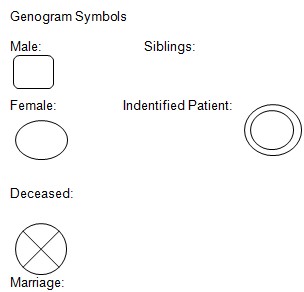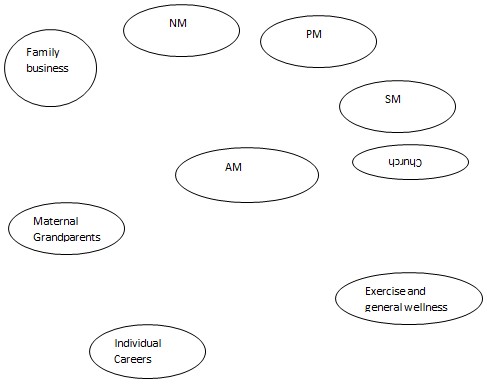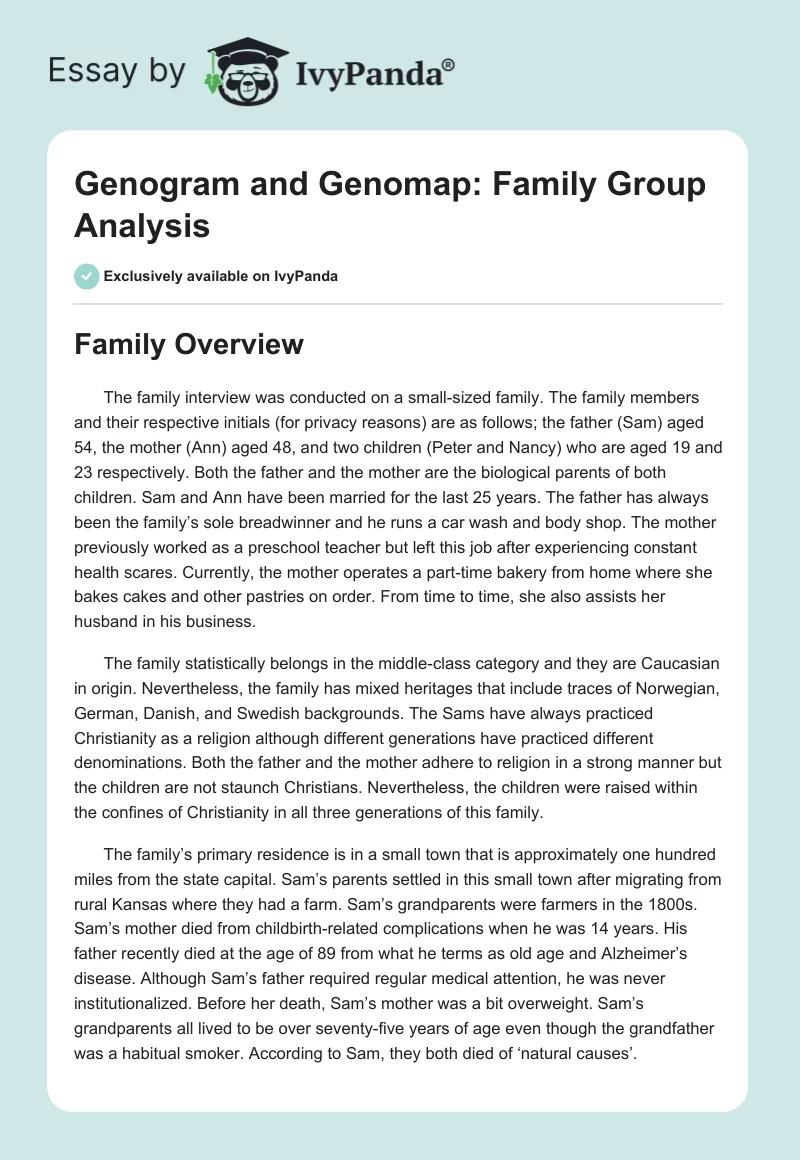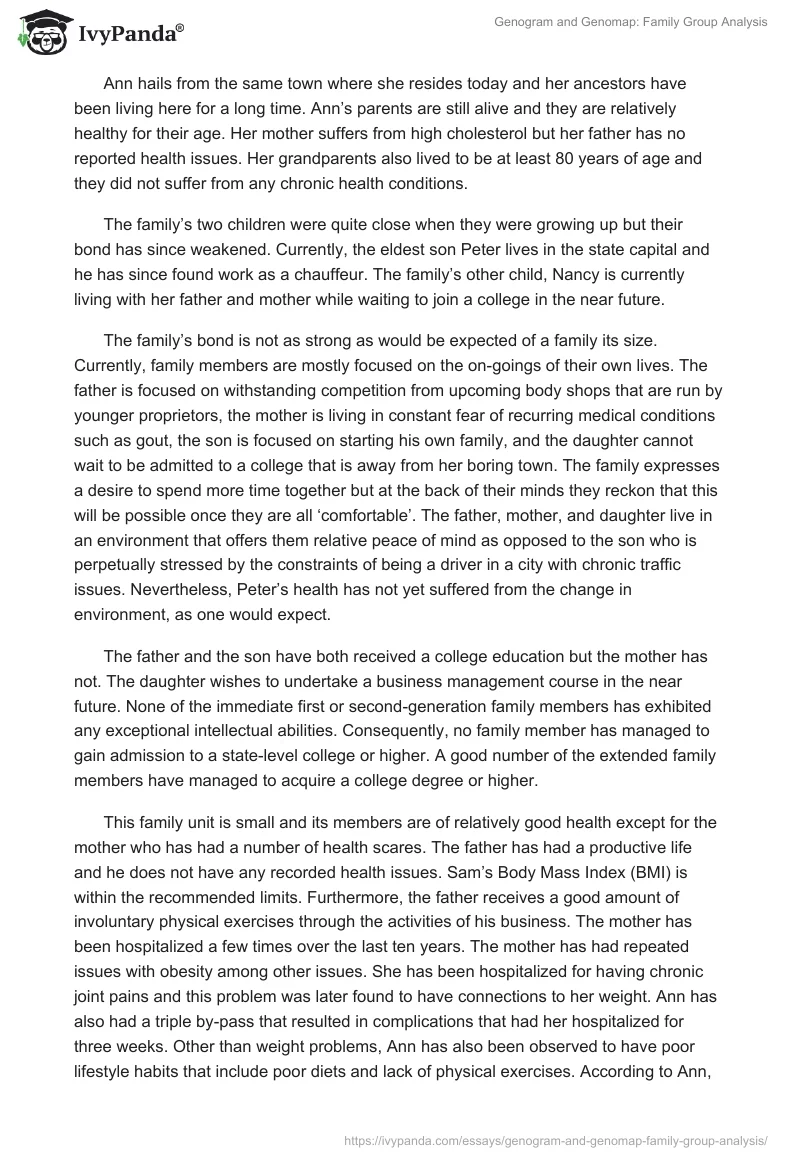Family Overview
The family interview was conducted on a small-sized family. The family members and their respective initials (for privacy reasons) are as follows; the father (Sam) aged 54, the mother (Ann) aged 48, and two children (Peter and Nancy) who are aged 19 and 23 respectively. Both the father and the mother are the biological parents of both children. Sam and Ann have been married for the last 25 years. The father has always been the family’s sole breadwinner and he runs a car wash and body shop. The mother previously worked as a preschool teacher but left this job after experiencing constant health scares. Currently, the mother operates a part-time bakery from home where she bakes cakes and other pastries on order. From time to time, she also assists her husband in his business.
The family statistically belongs in the middle-class category and they are Caucasian in origin. Nevertheless, the family has mixed heritages that include traces of Norwegian, German, Danish, and Swedish backgrounds. The Sams have always practiced Christianity as a religion although different generations have practiced different denominations. Both the father and the mother adhere to religion in a strong manner but the children are not staunch Christians. Nevertheless, the children were raised within the confines of Christianity in all three generations of this family.
The family’s primary residence is in a small town that is approximately one hundred miles from the state capital. Sam’s parents settled in this small town after migrating from rural Kansas where they had a farm. Sam’s grandparents were farmers in the 1800s. Sam’s mother died from childbirth-related complications when he was 14 years. His father recently died at the age of 89 from what he terms as old age and Alzheimer’s disease. Although Sam’s father required regular medical attention, he was never institutionalized. Before her death, Sam’s mother was a bit overweight. Sam’s grandparents all lived to be over seventy-five years of age even though the grandfather was a habitual smoker. According to Sam, they both died of ‘natural causes’.
Ann hails from the same town where she resides today and her ancestors have been living here for a long time. Ann’s parents are still alive and they are relatively healthy for their age. Her mother suffers from high cholesterol but her father has no reported health issues. Her grandparents also lived to be at least 80 years of age and they did not suffer from any chronic health conditions.
The family’s two children were quite close when they were growing up but their bond has since weakened. Currently, the eldest son Peter lives in the state capital and he has since found work as a chauffeur. The family’s other child, Nancy is currently living with her father and mother while waiting to join a college in the near future.
The family’s bond is not as strong as would be expected of a family its size. Currently, family members are mostly focused on the on-goings of their own lives. The father is focused on withstanding competition from upcoming body shops that are run by younger proprietors, the mother is living in constant fear of recurring medical conditions such as gout, the son is focused on starting his own family, and the daughter cannot wait to be admitted to a college that is away from her boring town. The family expresses a desire to spend more time together but at the back of their minds they reckon that this will be possible once they are all ‘comfortable’. The father, mother, and daughter live in an environment that offers them relative peace of mind as opposed to the son who is perpetually stressed by the constraints of being a driver in a city with chronic traffic issues. Nevertheless, Peter’s health has not yet suffered from the change in environment, as one would expect.
The father and the son have both received a college education but the mother has not. The daughter wishes to undertake a business management course in the near future. None of the immediate first or second-generation family members has exhibited any exceptional intellectual abilities. Consequently, no family member has managed to gain admission to a state-level college or higher. A good number of the extended family members have managed to acquire a college degree or higher.
This family unit is small and its members are of relatively good health except for the mother who has had a number of health scares. The father has had a productive life and he does not have any recorded health issues. Sam’s Body Mass Index (BMI) is within the recommended limits. Furthermore, the father receives a good amount of involuntary physical exercises through the activities of his business. The mother has been hospitalized a few times over the last ten years. The mother has had repeated issues with obesity among other issues. She has been hospitalized for having chronic joint pains and this problem was later found to have connections to her weight. Ann has also had a triple by-pass that resulted in complications that had her hospitalized for three weeks. Other than weight problems, Ann has also been observed to have poor lifestyle habits that include poor diets and lack of physical exercises.
According to Ann, no matter how hard she tries, she has not been able to commit to good health practices. Ann’s decision to quit her job as a teacher was prompted by the fact that she felt that this vocation was taking a toll on her health. Peter is the most fit member of the family and he has almost no recorded health issues. He was active in sports during both his high school and community college days. He is also the only member of the family who visits a gym on regular basis. The daughter’s main health issue and sole concern is centered on the fact that she does not want to be ‘fat’ like her mother and maternal grandmother. Consequently, Nancy lives on strict dietary regimens and some members of her family have raised concerns that she might have an eating disorder. Nevertheless, Nancy rarely engages in physical exercises.
The Problem
Last month the father explicitly expressed his desire to seek a divorce from Ann. Both Ann and Sam are practicing Christians and they have always believed that divorce was a distant thing for them. According to Sam, he would have asked for the divorce a long time ago and he only remained in the marriage for the kids’ benefit. However, both their children are now grownups and according to Sam, they should be in a position to understand the dynamics of adult relationships. Sam’s decision to seek for a divorce is due to the fact that he is no longer attracted to his wife. On the other hand, Ann suspects that her husband is in a parallel secret relationship but she does not have any solid proof.
The two have not yet been intimate for approximately three years. The thought of being divorced has plunged Ann into an emotional turmoil and she is ready to do everything to salvage her relationship. This issue has also prompted Ann to develop high blood pressure and turn to comfort foods for solace. Although the parents have not informed Nancy who still lives with them, she has learnt about it on her own. Consequently, she has had emotional distress and she spends most of her time locked away in her room with her communication gadgets. In Ann’s view, her husband can be attracted to her if she went back to being skinny like she used to before she got her two children. Consequently, she is prepared to undergo some extreme surgical procedures to save her marriage. On the other hand, Sam says that he has ‘done right by his family’ and his decision is not subject to change. His wife is particularly furious because he has never expressed his concerns openly throughout their entire marriage.

Clinical Hypothesis
The concept of reciprocal determinism advocates that when cataloging relationship issues, the ‘process’ is more important than the ‘content’. In this case, when trying to offer solutions to the Sam family, “it is important not to dwell on historical facts as explanations for the current problems and focus on the sequence of communication exchanges within the family setting” (Goldenberg & Goldenberg, 2013, p. 21). For example, the problem between the father and the mother began a long time ago when the former was unable to express his feelings towards his wife. Nevertheless, the wife should have been able to read the indirect communications between them and sought clarification. Following the concept of reciprocal determinism, the couple should retrace their communications as the only way to sort out their current dilemma.
Although this was a family case study, the mother (Ann) fits the description of the ‘identified patient’ (IP). According to Goldenberg’s book, “family therapists have since identified that when the IP came out for help, his/her entire family was hurting and it also needed help” (Goldenberg & Goldenberg, 2013, p. 26). In this scenario, the mother is expressing emotional turmoil as a result of her impending divorce. However, after a close analysis it is clear that both her husband and daughter are also hurting from this development. All subsequent psychoanalysis should take the relationships of the IP into account. For instance, it is very likely that other members of the Sam family would benefit from counseling services.
The stage model of family development as outlined in chapter two of the Rosenbergs’ book is not a foolproof method of conceptualizing a family (Goldenberg & Goldenberg, 2013). In the case of the Sam family, they have adhered to this stage model until the time of the parents’ imminent divorce. The stage model fails to acknowledge dysfunctions within normal families. The Sam family dilemma is not an isolated incident and it has been replicated in other families across the country. For instance, statistics indicate that divorce has become common among couples who are over fifty years of age (Hetherington, 2012). At this stage in the Sam family-cycle, the stage model assumes that the family would be in the last stage where they accept old age and move on. However, if the parents go ahead with their divorce this development will create inconsistencies within the stage model. Therefore, counseling this family requires a more complicated approach than would be the case with a traditional family.
Culture sensitive therapy specifies that effective family therapy should take into account cultural diversity. Consequently, a practicing nurse would not apply counseling services in a one size fits all model. The same applies to Sam and Ann’s family where the therapist needs to take into account various cultural factors. First, the family is Caucasian and its members are traditional Lutheran Christians. Nevertheless, working on this family also means that the nurse cannot blindly apply Caucasian-related cultural stereotypes.
The general systems theory “offers a set of assumptions regarding the maintenance of an organism or entity (including families) as a result of the complex interaction of its elements or parts” (Goldenberg & Goldenberg, 2013, p. 77). Consequently, the wholeness of any family is dependent on various and separate factors. Therefore, Sam and his family are an entity that exists as a result of various relationships and interrelationships. Therefore, the wife is right to be worried about the possibility of a divorce because ‘she cannot be understood in isolation’ since a family only functions fully as a whole. According to the systems theory, the current basic structure of the Sam family would be destabilized by a divorce.
Main hypothesis: The main problem for this family lies in the fact that the bonds within family members have weakened continuously over a long period of time. The sequence of communicative exchanges explicitly indicates that members of the family have created distances between them and their relationships need repair. Most of the problems that this family is facing can be traced back to the mother as the IP. If the problems of this family are because the family is deviating from the stage model of family development, then effective counseling can repair its relationships no matter the outcome of the divorce proposal.

Key Symbols
- Strong Relationship:
- Weak Relationship:
- Stressful Relationship:
Therapeutic Approach
Structural family therapy model is a therapeutic approach that aims at strengthening family structures. Structural family therapy is a “strength-based, outcome oriented modality based on eco-systemic principles” (Aponte, 2012). According to the structural therapy model, people’s behaviors are influenced by inter-relationships. The structural method also operates under the assumption that the family is the most important part of a person’s identity. Furthermore, the model asserts that a well-functioning family is not characterized by lack of individual or family-based stressors. Within the structural model, “the work of the structural family therapist is to locate and mobilize underutilized strengths, helping the family outgrow constraining patterns of interaction that impede the actualization of its own resources” (Minuchin, 2012).
This model was chosen because the underlying problems within the Sam household can be traced to deeper interrelations of the family members (Hetherington, 2012). Furthermore, the structural family therapy model is effective for dysfunctional families such as the one that is outlined in this case study.
The goals of therapy in relation to counseling the Sam family integrity include ensuring that intercommunication is restored. The other goal is to enforce shared responsibilities within the family by proving that all members of the family are liable for the unfolding events. Furthermore, the counseling session also aims to use the family hierarchy with the view of eliminating dysfunctions. Finally, the therapy will ensure that the family uses its strengths for its own benefits.
The first intervention in the Sam family therapy involves systematically reframing the family structures. In this case, Sam needs to retake his role as the supreme leader of the family. For instance, in the latter years Sam has been using his work as an excuse for not spending time with his family. This intervention is expected to repair the bonds that have sustained this family for the last 24 years. The other important intervention in regards to the Sam family therapy is to challenge the family’s worldview (McGoldrick, Gerson, & Petry, 2008). The most prominent problem in this family occurred because the wife and the husband had different worldviews. For instance, the wife was of the view that their religion cautioned the family from disintegration/divorce but the husband does not agree with this outlook. By challenging the family’s worldview, the nurse will bring the family members to a discussion that might yield intellectual benefits. Another possible intervention involves using compliments to shape the competence of family members (Wright & Leahey, 2009). For example, Ann has struggled with her obesity issues possibly due to lack of complimentary support. Furthermore, Nancy’s extreme and questionable diet choices might be fixed through compliments that can enhance her competence. This intervention is expected to foster individual growth whilst enhancing familial bonds.
References
Aponte, H. (2012). Training the person of the therapist in structural family therapy. Journal of Marital and Family Therapy, 18(3), 269-281.
Goldenberg, H., & Goldenberg, I. (2013). Family therapy: An overview (8th ed.). Florence, KY: Brooks/Cole Publishing.
Hetherington, E. M. (2012). Coping with marital transitions: A family systems perspective. Monographs of the Society for Research in Child Development, 57(2‐3), 1-14.
McGoldrick, M.,Gerson, R., & Petry, S. (2008). Genograms, assessment, and interventions (3rd ed.). New York, NY: W.W. Norton and Company.
Minuchin, S. (2012). About Structural family therapy. Web.
Wright, M., & Leahey, M. (2009). Nurse and Families: A Guide to Family Assessment and Intervention (5th ed.). Philadelphia, PA: F. A. Davis Company.


